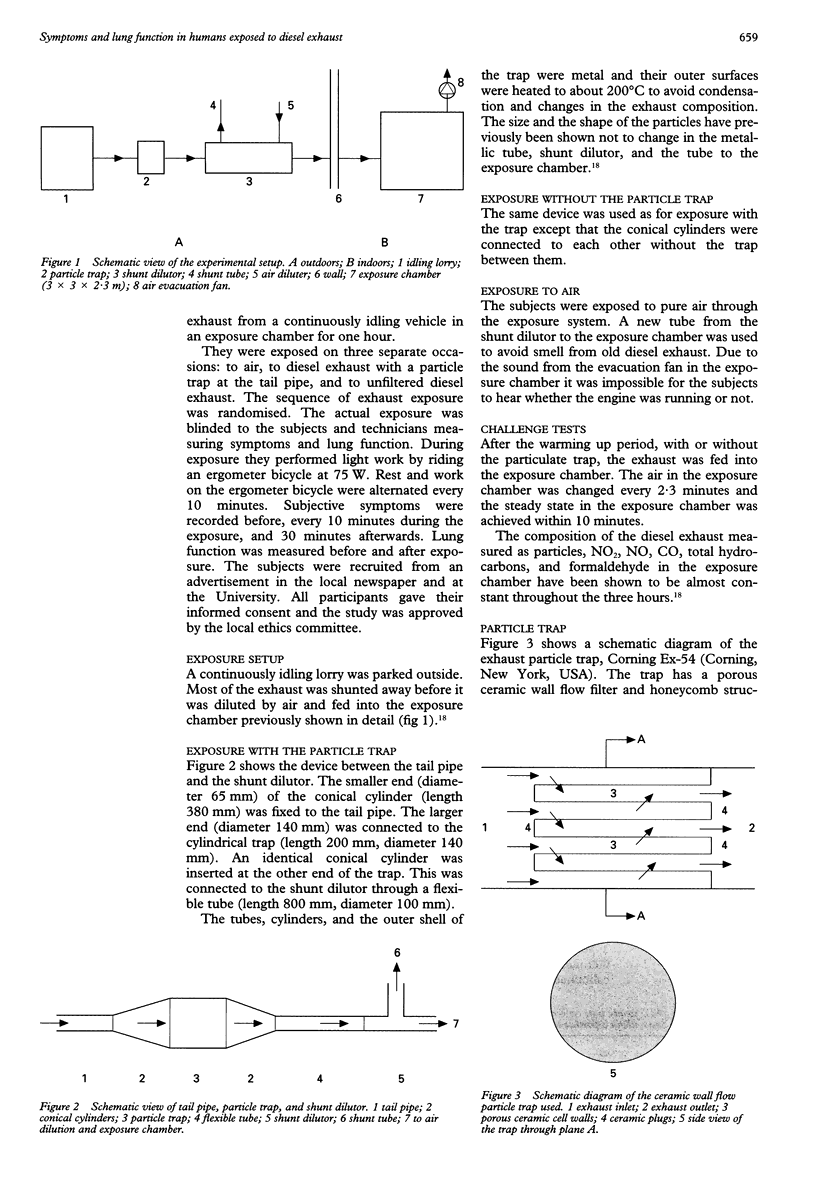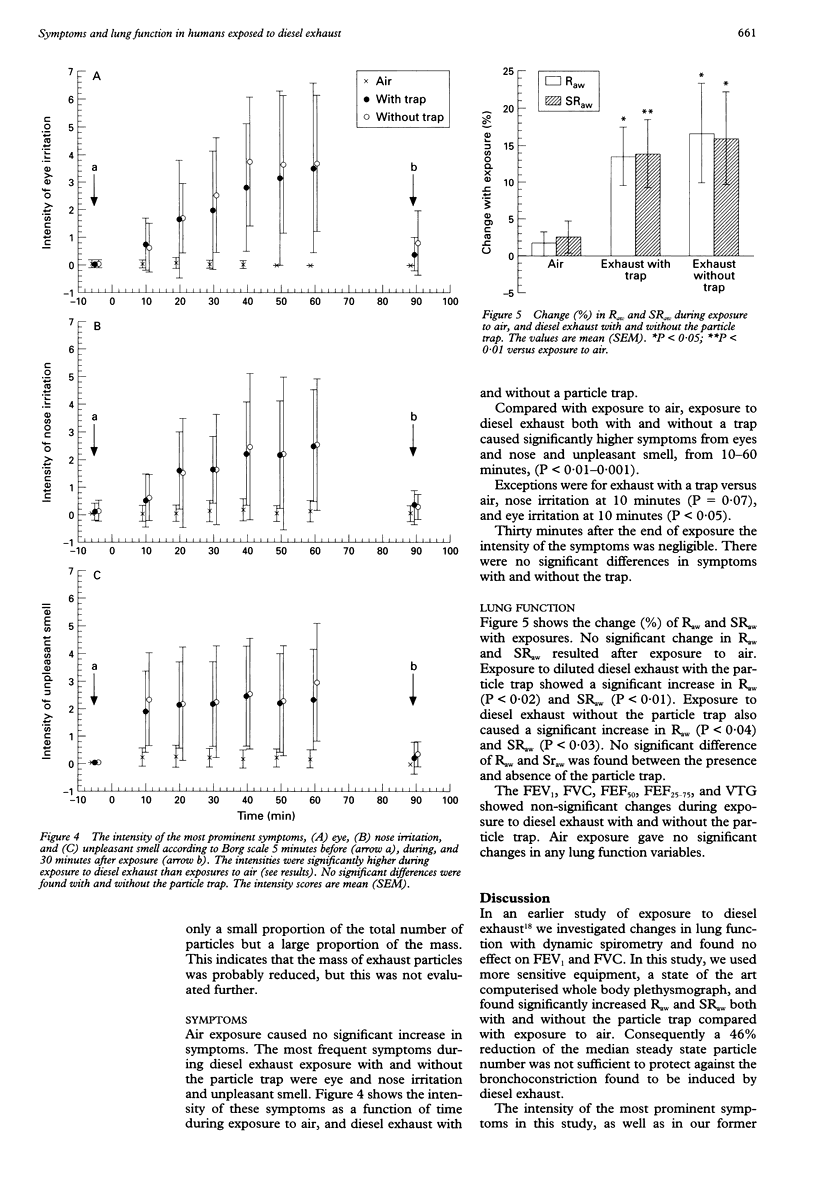Abstract
OBJECTIVES: Diesel exhaust is a common air pollutant made up of several gases, hydrocarbons, and particles. An experimental study was carried out which was designed to evaluate if a particle trap on the tail pipe of an idling diesel engine would reduce effects on symptoms and lung function caused by the diesel exhaust, compared with exposure to unfiltered exhaust. METHODS: Twelve healthy non-smoking volunteers (aged 20-37) were investigated in an exposure chamber for one hour during light work on a bicycle ergometer at 75 W. Each subject underwent three separate double blind exposures in a randomised sequence: to air and to diesel exhaust with the particle trap at the tail pipe and to unfiltered diesel exhaust. Symptoms were recorded according to the Borg scale before, every 10 minutes during, and 30 minutes after the exposure. Lung function was measured with a computerised whole body plethysmograph. RESULTS: The ceramic wall flow particle trap reduced the number of particles by 46%, whereas other compounds were relatively constant. It was shown that the most prominent symptoms during exposure to diesel exhaust were irritation of the eyes and nose and an unpleasant smell increasing during exposure. Both airway resistance (R(aw)) and specific airway resistance (SR(aw)) increased significantly during the exposures to diesel exhaust. Despite the 46% reduction in particle numbers by the trap effects on symptoms and lung function were not significantly attenuated. CONCLUSION: Exposure to diesel exhaust caused symptoms and bronchoconstriction which were not significantly reduced by a particle trap.
Full text
PDF




Selected References
These references are in PubMed. This may not be the complete list of references from this article.
- Attfield M. D., Trabant G. D., Wheeler R. W. Exposure to diesel fumes and dust at six potash mines. Ann Occup Hyg. 1982;26(1-4):817–831. [PubMed] [Google Scholar]
- Ayres S. M., Evans R., Licht D., Griesbach J., Reimold F., Ferrand E. F., Criscitiello A. Health effects of exposure to high concentrations of automotive emissions. Studies in bridge and tunnel workers in New York City. Arch Environ Health. 1973 Sep;27(3):168–178. doi: 10.1080/00039896.1973.10666347. [DOI] [PubMed] [Google Scholar]
- Borg G. A. Psychophysical bases of perceived exertion. Med Sci Sports Exerc. 1982;14(5):377–381. [PubMed] [Google Scholar]
- Gamble J., Jones W., Hudak J. An epidemiological study of salt miners in diesel and nondiesel mines. Am J Ind Med. 1983;4(3):435–458. doi: 10.1002/ajim.4700040305. [DOI] [PubMed] [Google Scholar]
- Gamble J., Jones W., Minshall S. Epidemiological-environmental study of diesel bus garage workers: acute effects of NO2 and respirable particulate on the respiratory system. Environ Res. 1987 Feb;42(1):201–214. doi: 10.1016/s0013-9351(87)80022-1. [DOI] [PubMed] [Google Scholar]
- Gamble J., Jones W., Minshall S. Epidemiological-environmental study of diesel bus garage workers: chronic effects of diesel exhaust on the respiratory system. Environ Res. 1987 Oct;44(1):6–17. doi: 10.1016/s0013-9351(87)80082-8. [DOI] [PubMed] [Google Scholar]
- Lewtas J. Evaluation of the mutagenicity and carcinogenicity of motor vehicle emissions in short-term bioassays. Environ Health Perspect. 1983 Jan;47:141–152. doi: 10.1289/ehp.8347141. [DOI] [PMC free article] [PubMed] [Google Scholar]
- Reger R., Hancock J., Hankinson J., Hearl F., Merchant J. Coal miners exposed to diesel exhaust emissions. Ann Occup Hyg. 1982;26(1-4):799–815. [PubMed] [Google Scholar]
- Rudell B., Sandström T., Hammarström U., Ledin M. L., Hörstedt P., Stjernberg N. Evaluation of an exposure setup for studying effects of diesel exhaust in humans. Int Arch Occup Environ Health. 1994;66(2):77–83. doi: 10.1007/BF00383361. [DOI] [PubMed] [Google Scholar]
- Sandström T. Respiratory effects of air pollutants: experimental studies in humans. Eur Respir J. 1995 Jun;8(6):976–995. [PubMed] [Google Scholar]
- Scheepers P. T., Bos R. P. Combustion of diesel fuel from a toxicological perspective. I. Origin of incomplete combustion products. Int Arch Occup Environ Health. 1992;64(3):149–161. doi: 10.1007/BF00380904. [DOI] [PubMed] [Google Scholar]
- Schuetzle D., Frazier J. A. Factors influencing the emission of vapor and particulate phase components from diesel engines. Dev Toxicol Environ Sci. 1986;13:41–63. [PubMed] [Google Scholar]
- Ulfvarson U., Alexandersson R., Aringer L., Svensson E., Hedenstierna G., Hogstedt C., Holmberg B., Rosén G., Sorsa M. Effects of exposure to vehicle exhaust on health. Scand J Work Environ Health. 1987 Dec;13(6):505–512. doi: 10.5271/sjweh.2012. [DOI] [PubMed] [Google Scholar]
- Ulfvarson U., Alexandersson R., Dahlqvist M., Ekholm U., Bergström B. Pulmonary function in workers exposed to diesel exhausts: the effect of control measures. Am J Ind Med. 1991;19(3):283–289. doi: 10.1002/ajim.4700190303. [DOI] [PubMed] [Google Scholar]
- Ulfvarson U., Alexandersson R. Reduction in adverse effect on pulmonary function after exposure to filtered diesel exhaust. Am J Ind Med. 1990;17(3):341–347. doi: 10.1002/ajim.4700170306. [DOI] [PubMed] [Google Scholar]


